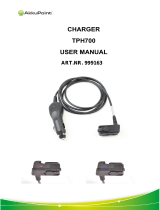
6
When is charging complete?
When the charge indicators stop scrolling, your
phone is considered fully charged. However, a
slight increase in charge may occur if you leave
your phone connected to the charger.
When is a good time to charge?
You can charge anytime, but remember that when your
phone displays
%DWWHU\ ORZ
, you only have a couple of
minutes of talk time left.
Can I make calls while charging?
Yes, but your battery may not charge during a call. Charging
should resume once you end the call.
Discharging NiMH batteries
For good operation times, discharge NiMH batteries from
time to time by leaving your phone switched on until it
turns itself off (or by using the battery discharge facility of
any approved accessory available for your phone). Do not
attempt to discharge the battery by any other means.
Important battery information
• The battery can be charged and discharged hundreds of times
but it will eventually wear out. When the operating time (talk
time and standby time) is noticeably shorter than normal, it is
time to buy a new battery.
• Use only batteries approved by the phone manufacturer and
recharge your battery only with the chargers approved by the
manufacturer. When a charger is not in use, disconnect it from
the power source. Do not leave the battery connected to a
charger for longer than a week, since overcharging may shorten
its life. If left unused a fully charged battery will discharge itself
over time.
• Temperature extremes will affect the ability of your battery to
charge: allow it to cool down or warm up first.
• Use the battery only for its intended purpose.




















